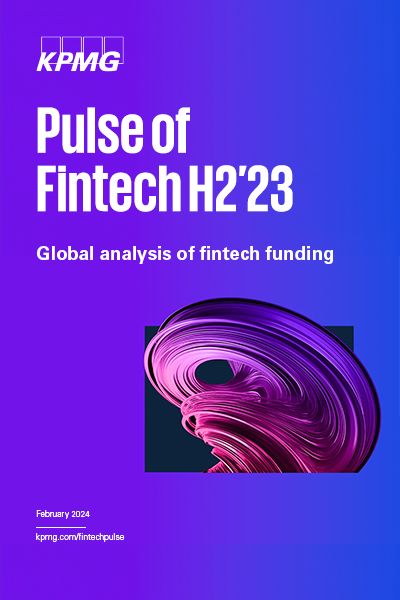Fintech investment in 2023 exhibited restraint, with year-over-year declines across all regions. Only proptech and insurtech saw an increase in total investment. However, start-up and seed funding continued to rise, reaching an all-time high in deal count.
In the EMEA region, total investment amounted to $24.5 billion, the lowest figure in seven years. Encouragingly, the funding nearly doubled in the second half of 2023 compared to the first half.
Belgium, in particular, experienced a significant drop in the number of deals from 38 in 2022 to 10 in 2023. While the value of deals was lower than the extraordinary $760 million in 2022, it was comparable to that of 2020, at close to $100 million. This was largely due to large financing rounds for Credix and Qover.
H2 2023 - Pulse of Fintech latest edition
2023 was a difficult year for the fintech market globally, with both total fintech investment ($113.7 billion) and the number of fintech deals (4,547) experiencing their weakest results since 2017. A storm of global challenges — from the high interest rate environment and stubbornly high inflation in many jurisdictions, to conflicts in the Ukraine and Middle East — combined with concerns about valuations and the barren exit environment, saw fintech investors becoming increasingly cautious with their investments.
The year-over-year decline in fintech investment occurred across all key regions, with ASPAC experiencing the largest drop — from $51.3 billion in 2022 to just $10.8 billion in 2023. EMEA saw investment fall from $49.6 billion to $24.5 billion over the same timeframe. The Americas showed the most resilience, with fintech investment dropping from $95.4 billion in 2022 to $78.3 billion in 2023. At a jurisdictional level, the US attracted two-thirds of all fintech funding during 2023 ($73.5 billion).
The payments space continued to account for the largest share of fintech funding among the fintech subsectors, despite a drop from $57.9 billion to $20.7 billion between 2022 and 2023. Of the major fintech subsectors, only proptech and insurtech saw total investment rise year-over-year, with proptech investment rising from $4.1 billion to $13.4 billion, and insurtech investment growing from $5.9 billion to $8.1 billion. From a technology perspective, despite a drop in funding in 2023, AI remained a clear leader, attracting over $12.1 billion in fintech investment.
- Increased scrutiny of potential fintech deals, including a very strong focus on profitability and avoidance of down rounds.
- Strengthening interest in B2B fintech solutions aimed at enablement rather than on B2C-focused business models.
- Enhanced focus on partnerships and alliances.
- Growing interest in the applicability of AI and generative AI across the fintech sector.
- Continued focus on embedded financial products, particularly payments and lending, as part of transition to opening banking.
Looking ahead to the first half of 2024, investment in the fintech sector globally is expected to remain relatively soft, although investment will likely begin to pick up as interest rates reduce with common consensus that this will be in Q3/Q4. AI will likely continue to be a key focus, in addition B2B solutions. M&A activity is also expected to rise as investors look for opportunities to buy distressed assets.
One area that has bucked the trend in the fintech life stage, is start-up and seed/ pre-seed funding. While the deal sizes are small as investors spread their risk, the number of deals completed is at an all time high. Clearly, investors are testing and learning which next wave, fintech business model, will be commercially desirable.
Whether you’re the founder of an emerging fintech or the CEO of a large financial institution, it’s important to consider how your company can drive the most value from your operational activities so that you are well positioned to be sustainable long-term. As you read this edition of Pulse of Fintech, ask yourself: What can we do to enhance our profitability and ensure we’re sustainable for the long-term.
Explore
Connect with us
- Find office locations kpmg.findOfficeLocations
- kpmg.emailUs
- Social media @ KPMG kpmg.socialMedia





